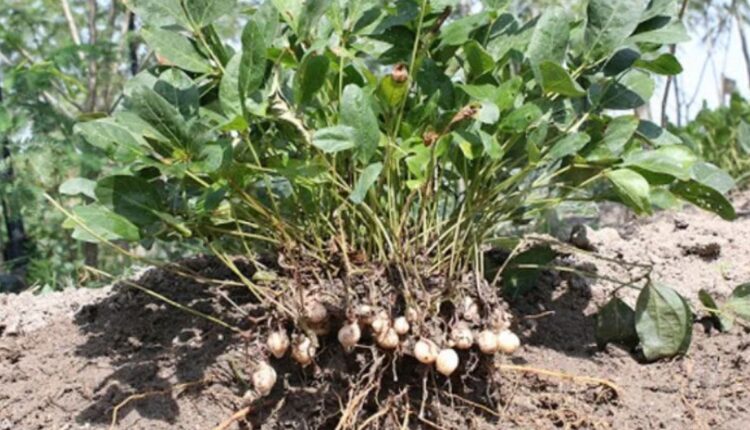Groundnut Seed: “The moment a seed is sown, farmer starts worrying – what if the sprout rots, what if the plant gets scorched?”
If you grow groundnut, you too must have had this worry at some point.
And the solution is – seed treatment.
Groundnut is a major oilseed crop connected to the livelihood of millions of farmers in India. But it is often seen that crops suffer heavy losses due to fungal and bacterial diseases. These diseases mostly start from the seed itself. Therefore, if the seed is properly treated before sowing, the crop not only remains safe from diseases but its yield and quality both improve.
This article will give you complete information about modern, traditional, and organic methods of seed treatment, so that every farmer can understand and benefit from applying it in their field.
What is Seed Treatment?
Seed treatment means preparing a protective layer on seeds before sowing, so that hidden germs, fungus, or bacteria are eliminated, and the seeds become fully capable of producing healthy plants.
In simple words, just like we get vaccinated to protect our bodies from diseases, in the same way, giving a “protective shield” to seeds at the very start of the crop is called seed treatment.
Why is Seed Treatment Needed?
• Fungus and bacteria present on or inside seeds from before can harm the plant during germination.
These diseases spread in the field and affect the entire crop.
• Sometimes seeds rot or fail to sprout — wasting the farmer’s time, labor, and money.
Why is Seed Treatment Essential?
• Protection from seed-borne diseases
• Germination rate increases
Disease resistance develops in plants
Spread of diseases in the field is controlled
• Both yield and quality become better
Methods of Seed Treatment in Groundnut
1. Physical Treatment
• Sun-drying: Drying seeds in strong sunlight for 2–3 hours helps reduce moisture and fungus present in them.
• Hot water treatment: Soak seeds in 50°C hot water for 30 minutes — this reduces bacterial infections.
2. Chemical Treatment
| Name of Chemical | Quantity (per kg seed) | Function |
| Thiram | 2–3 grams | Fungicide |
| Captan | 2–3 grams | Prevents seed rot |
| Carbendazim | 1–2 grams | Protects against collar rot and other diseases |
| Streptocycline | 0.5 grams + 1 liter water | Controls bacterial diseases |
Tip: Do not mix chemicals together unless advised by a trusted scientific source.
3. Biological Treatment
| Organic Agent | Quantity | Benefits |
| Trichoderma viride | 4 grams/kg seed | Fungicide, root protection |
| Pseudomonas fluorescens | 5 grams/kg seed | Bacterial control |
| Cow urine–neem extract mix | 1:10 ratio | Natural disease resistance |
How to do it: Wet the seeds slightly with water, then mix thoroughly with biological powder. Dry in shade and sow immediately.
Step-by-Step Guide to Seed Treatment
Seed treatment is an easy but extremely important process that every farmer should adopt. By following the steps given below, you can give your groundnut crop a strong start:
Step 1: Select good quality seeds
• First, sort the seeds that are uniform in size, heavy, and without stains.
• Remove infected, broken, or very light seeds.
Even if the seeds are from your own field, test them – as diseases often spread from soil and storage.
Step 2: Sun-dry the seeds
After cleaning, spread the seeds on a dry mat or tarpaulin in strong sunlight for 2–3 hours.
• This removes hidden moisture and reduces fungus or bacterial impact.
Step 3: Treat the seeds – Organic or Chemical
• Now treat the seeds. Choose your option depending on your farming method (organic or conventional).
Step 4: Dry in shade
• Spread the treated seeds in one layer on a plastic mat and dry in the shade.
Drying in sunlight may destroy biological agents and cause seeds to stick to each other.
Step 5: Do not delay sowing
• Seeds should be sown within 24 hours of treatment.
• Delaying reduces the seed’s vitality and the effect of the treatment.
Practical Tips for Farmers
• Do seed treatment before rains, because fungal infection spreads faster in moisture.
In dry weather, Trichoderma or Carbendazim are very effective – they prevent root rot.
Organic farmers can use cow urine, neem oil, or organic fungicides.
• Seed treatment should be done every year, whether the seeds are purchased or saved from your own field – this habit is the first step of crop protection.
Government Schemes and Support
• Krishi Vigyan Kendras (KVK) regularly organize free seed treatment camps and training workshops.
• ICAR (Indian Council of Agricultural Research) certified organic products are now easily available in the market.
In some districts, state governments provide seed treatment kits free or on subsidy – contact your local agriculture officer for this.
Seed treatment is a simple but extremely beneficial process.
It provides protection to the crop right from the beginning and prevents many future problems. Farmers should make this process a part of their farming routine and achieve better yields year after year.
For a good groundnut crop and profitable production, seed treatment is a necessary step.
If Indian farmers combine traditional knowledge with modern scientific techniques, they can prepare disease-free and higher-yielding fields.
A little caution, some preparation, and affordable techniques can save crops worth lakhs.
Contact us – If farmers want to share any valuable information or experiences related to farming, they can connect with us via phone or whatsapp at 9599273766 or you can write to us at “[email protected]”. Through Kisan of India, we will convey your message to the people, because we believe that if the farmers are advanced then the country is happy.
You can connect with Kisan of India on Facebook, Twitter, and Whatsapp and Subscribe to our YouTube channel.



